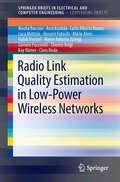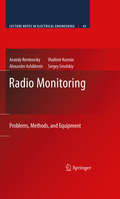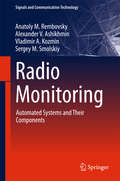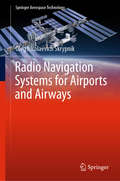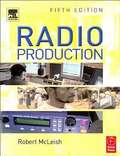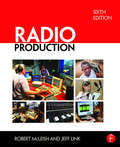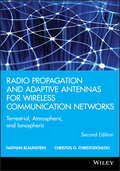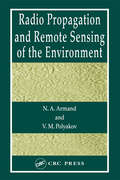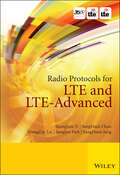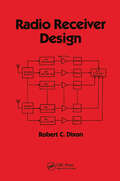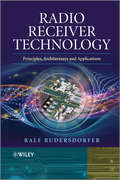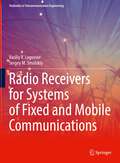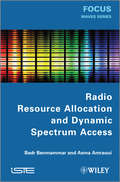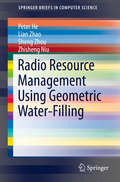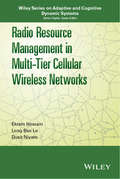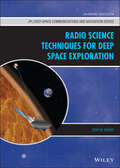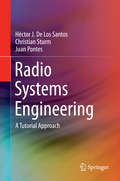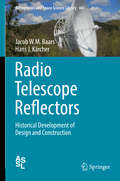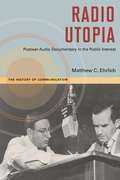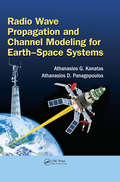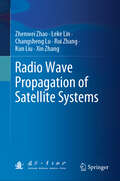- Table View
- List View
Radio Interfaces in the Internet of Things Systems: Performance studies
by Kamil StaniecThe book gives a broad overview of the Internet of Things (IoT) concept from various angles. The book provides rationale for: the concept development; its regulatory and technical background associated aspects such as the ambient and edge intelligence; fog computing; capillary networks and machine-type communications; etc. Each of these items is then extended in further respective chapters that deal with technicalities behind them. Chapters: 2-5, 8, 10-11 are addressed to those who seek expository IoT-related information on aspects such as the pathloss calculation, narrowband radio interfaces, radiation masks, spectrum matters, medium access control, and a transmission frame construction. That section ends with an exhaustive description of the six most popular IoT systems: LoRa, Weightless, SigFox, NB-IoT, LTE-M(TC) and EC-GSM IoT. Specialists and network designers may find chapters 6 and 7 interesting where a novel methodology is proposed for testing narrowband IoT systems performance for immunity to electromagnetic interference (EMI) and multipath propagation, both emulated in artificial conditions of the anechoic and the reverberation chamber.
Radio Link Quality Estimation in Low-Power Wireless Networks
by Marco Antonio Zuniga Carlo Alberto Boano Claro Noda Luca Mottola Habib Youssef Hossein Fotouhi Daniele Puccinelli Anis Koubâa Kay Römer Mário Alves Nouha Baccour Thiemo VoigtThis book provides a comprehensive survey on related work for radio link quality estimation, which covers the characteristics of low-power links, the fundamental concepts of link quality estimation in wireless sensor networks, a taxonomy of existing link quality estimators and their performance analysis. It then shows how link quality estimation can be used for designing protocols and mechanisms such as routing and hand-off. The final part is dedicated to radio interference estimation, generation and mitigation.
Radio Monitoring
by Alexander Ashikhmin Vladimir Kozmin Sergey M. Smolskiy Anatoly RembovskyRadio Monitoring: Problems, Methods, and Equipment offers a unified approach to fundamental aspects of Automated Radio Monitoring (ARM). The authors discuss the development, modeling, design, and manufacture of ARM systems. Data from established and recent research are presented and recommendations are made on methods and approaches for solving common problems in ARM. The authors also provide classification and detailed descriptions of modern high-efficient hardware-software ARM equipment, including the equipment for detection, radio direction-finding, parameters measurement and their analysis, and the identification and localization of the electromagnetic field sources. Examples of ARM equipment structure, applications, and software are provided to manage a variety of complicated interference environment in the industrial centers, inside of the buildings, and in the open terrain. This book provides a reference for professionals and researchers interested in deploying ARM technology as a tool for solving problems from radio frequency spectrum usage control.
Radio Monitoring: Problems, Methods And Equipment (Lecture Notes In Electrical Engineering #43)
by Sergey M. Smolskiy Anatoly M. Rembovsky Alexander V. Ashikhmin Vladimir A. KozminThis book discusses the architecture of modern automated systems for spectrum monitoring including automation components: technical means for spectrum monitoring, special software and engineering infrastructure. The problems of automated system development for search and localization of unauthorized radio emission sources in open localities, mathematical methods and algorithms for modulation of parameter measurements for wireless communication as well as issues of identification and localization of radio emission sources are considered. Constructive solutions and modern technical means for radio monitoring and their application are given. Numerous examples are described for the implementation of automated systems, digital radio receivers and radio direction-finders, analyzers of parameters for GSM, CDMA, LTE, DVB-T/T2, Wi-Fi, DMR, P25, TETRA and DECT signals. Practical implementations of the described methods are presented in applied software packages and in radio monitoring equipment.
Radio Navigation Systems for Airports and Airways (Springer Aerospace Technology)
by Oleg Nicolaevich SkrypnikThis book highlights the design principles of ground based radio-navigation systems used in solving navigation tasks in the airfield and on air routes. Mathematical correlations are illustrated that describe its operation, peculiarities of disposition, main technical characteristics, generalized structural diagrams as well as the inter-operation with onboard equipment. Examples of building, construction, functional diagrams, and characteristics of Russian made radio-navigation systems are discussed. This book is written for students of electronics and aviation disciplines. It can also be useful for aviation specialists as well as for those interested in air radio-navigation.
Radio Production
by Robert McleishThis classic book is a must-have for anyone involved in radio production, covering everything from operational techniques and producing different programme formats, to conducting interviews and writing for radio.The fifth edition features new and updated information on:* digital production, such as the computer editing process, digital recording and DAB* the internet and internet-only radio stations* automatic playout systems* ethics* storytelling, showing simple ways of creating different acoustics for drama* station management* scheduling* remote reportingThis edition is further enhanced by a supporting CD-Rom, packed with examples, exercises and resources.
Radio Production: A Manual For Broadcasters (The\library Of Communication Techniques)
by Robert McLeish Jeff LinkRadio Production is for professionals and students interested in understanding the radio industry in today’s ever-changing world. This book features up-to-date coverage of the purpose and use of radio with detailed coverage of current production techniques in the studio and on location. In addition there is exploration of technological advances, including handheld digital recording devices, the use of digital, analogue and virtual mixing desks and current methods of music storage and playback. Within a global context, the sixth edition also explores American radio by providing an overview of the rules, regulations, and purpose of the Federal Communications Commission. The sixth edition includes: Updated material on new digital recording methods, and the development of outside broadcast techniques, including Smartphone use. The use of social media as news sources, and an expansion of the station’s presence. Global government regulation and journalistic codes of practice. Comprehensive advice on interviewing, phone-ins, news, radio drama, music, and scheduling. This edition is further enhanced by a companion website, featuring examples, exercises, and resources: www.focalpress.com/cw/mcleish.
Radio Propagation Measurement and Channel Modelling
by Sana SalousWhile there are numerous books describing modern wireless communication systems that contain overviews of radio propagation and radio channel modelling, there are none that contain detailed information on the design, implementation and calibration of radio channel measurement equipment, the planning of experiments and the in depth analysis of measured data.The book would begin with an explanation of the fundamentals of radio wave propagation and progress through a series of topics, including the measurement of radio channel characteristics, radio channel sounders, measurement strategies, data analysis techniques and radio channel modelling. Application of results for the prediction of achievable digital link performance would be discussed with examples pertinent to single carrier, multi-carrier and spread spectrum radio links. This work would address specifics of communications in various different frequency bands for both long range and short range fixed and mobile radio links.
Radio Propagation and Adaptive Antennas for Wireless Communication Networks
by Christos G. Christodoulou Nathan BlaunsteinExplores novel wireless networks beyond 3G, and advanced 4G technologies, such as MIMO, via propagation phenomena and the fundamentals of adapted antenna usage.Explains how adaptive antennas can improve GoS and QoS for any wireless channel, with specific examples and applications in land, aircraft and satellite communications.Introduces new stochastic approach based on several multi-parametric models describing various terrestrial scenarios, which have been experimentally verified in different environmental conditionsNew chapters on fundamentals of wireless networks, cellular and non-cellular, multiple access networks, new applications of adaptive antennas for positioning, and localization of subscribersIncludes the addition of problem sets at the end of chapters describing fundamental aspects of wireless communication and antennas.
Radio Propagation and Remote Sensing of the Environment
by N.A. Armand V.M. PolyakovThis book describes the processes of radio propagation and analyzes the equations that enable estimation of media. It explores propagation processes and related phenomena including absorption, refraction, reflection, and scattering. It also analyzes how knowledge of radiowave properties allows accurate estimations of media via inverse problems.
Radio Protocols for LTE and LTE-Advanced
by SeungJune Yi SungDuck Chun YoungDae Lee SungJun Park SungHoon JungProvides a unique focus on radio protocols for LTE and LTE-Advanced (LTE-A) Giving readers a valuable understanding of LTE radio protocols, this book covers LTE (Long-Term Evolution) Layer 2/3 radio protocols as well as new features including LTE-Advanced. It is divided into two sections to differentiate between the two technologies’ characteristics. The authors systematically explain the design principles and functions of LTE radio protocols during the development of mobile handsets. The book also provides essential knowledge on the interaction between mobile networks and mobile handsets. Among the first publications based on the 3GPP R10 specifications, which introduces LTE-A Beginning with an overview of LTE, topics covered include: Idle Mode Procedure; Packet Data Convergence Protocol and Public Warning Systems Presents the LTE radio interface protocol layers in a readable manner, to enhance the material in the standards publications From an expert author team who have been directly working on the 3GPP standards It is targeted at professionals working or intending to work in the area and can also serve as supplementary reading material for students who need to know how theory on the most extensively used mobile radio interface today is put into practice
Radio Receiver Design (Electrical and Computer Engineering)
by Robert DixonProvides a fundamental understanding of current as well as future concepts and techniques essential for systematically defining and manufacturing a receiver that is flexible yet functional in today's world. An excellent introduction to communications and the role of receivers in conveying information.
Radio Receiver Technology
by Ralf RudersdorferWritten by an expert in the field, this book covers the principles, architectures, applications, specifications and characterizations of radio receivers In this book, the author introduces the reader to the basic principles and theories of present-day communications receiver technology. The first section of the book presents realization concepts at the system level, taking into consideration the various types of users. Details of the circuitry are described providing the reader with an understanding of fully digitized radio receivers, offering an insight into the state-of-the-art. The remaining sections address radio receivers, particularly as two-port devices. Furthermore, the author outlines the fields of applications (with sample calculations and with reference to practical work) and their features and considers also the specialty of high-quality radio receivers. As can be seen from the multitude of terrestrial applications described in Part II, they are typically used for radio surveillance, signal intelligence, modern radio bearing and at the classical radio services. Parts III and IV describe the entire range of parameters that are useful for the characterization of these receivers. The description starts from the physical effect, or the explanation of the individual parameter, and then proceeds to the measuring technique for determining the parameters, highlighting problems, followed by explanatory notes with applicatory relevance. The measuring procedures described are the result of experiences gained in extended laboratory work and practical testing. With the model shown in Part IV, used for the operational evaluation detailing the intrinsic small range of interpretation, the book covers untreated research in the field. The Appendix provides among others valuable information about the dimensioning of receiving systems and the mathematical derivation of non-linear effects and as well as a useful method for converting different level specifications. Key Features: Introduces the basic principles and theories of present-day technologyDiscusses concepts at system level (aligned to the various types of users)Addresses (fully) digitized radio receivers focusing on the state-of-the-artClose contacts to the industry were utilized to show background informationEnables the reader to comprehend and evaluate the characteristic features and the performance of such systemsExamines the entire range of parameters that are characteristic of the technology including the physical effect and measuring techniquesIncludes results of experiences gained in extended laboratory work and practical testing with examplesProvides a uniform and systematic approach for ease of understanding e.g. many didactic figures for the visual illustration have been newly created as well as complete real-world examplesThis book will be an excellent resource to understand the principles of work, for professionals developing and testing radio receivers, for receiver users (e.g. at regulatory agencies, surveillance centers, secret services, classical radio communications services), technicians, engineers and technicians who work with RF-measurement instruments, postgraduate students studying in the field and university lecturers. Chartered radio amateurs and handlers/operators will also find this book insightful. Due to high level of detail, it also serves as a reference. By using the carefully edited alphabetical index with over 1,200 entries, the appropriate explanations can be found quickly in the text.
Radio Receivers for Systems of Fixed and Mobile Communications (Textbooks in Telecommunication Engineering)
by Sergey M. Smolskiy Vasiliy V. LogvinovThe textbook acquaints the reader with the architecture of receivers of analog and digital radio systems, helps to study the stages of designing a modern radio receiver and reveals the reasons and methods for its effective operation in networks for various purposes. Particular attention is paid to the methods of generating and processing signals in the receivers of digital systems with multiple access, which make it possible to provide data transfer rates close to the maximum possible (according to Shannon). As a textbook for students studying methods of optimal signal reception, the book will also be useful to specialists in the field of telecommunications involved in the development of radio receivers. The book shows how the development of theoretical, circuitry and integrated technologies led to the active introduction of algorithmic methods for signal processing changed both the design of receivers and the methods of forming the information flow in free space (MIMO, beamforming). The creation of a global 5G network based on heterogeneous networks puts forward new requirements for the architecture of receivers, which are determined by the requirements to achieve high data rates, low time delays or use in networks with coordinated multipoint transmission and reception (CoMP). To consolidate the knowledge gained, the book includes a complete set of materials for online classes, including questions and answers, a guide to solving problems for each chapter, and computer modeling units of receivers in the MicroCAP environment, based on preliminary calculations.
Radio Resource Allocation and Dynamic Spectrum Access (Focus Ser. #2)
by Asma Amraoui Badr BenmammarWe are currently witnessing an increase in telecommunications norms and standards given the recent advances in this field. The increasing number of normalized standards paves the way for an increase in the range of services available for each consumer. Moreover, the majority of available radio frequencies have already been allocated. This explains the emergence of cognitive radio (CR) – the sharing of the spectrum between a primary user and a secondary user. In this book, we will present the state of the art of the different techniques for spectrum access using cooperation and competition to solve the problem of spectrum allocation and ensure better management of radio resources in a radio cognitive context. The different aspects of research explored up until now on the applications of multi-agent systems (MAS) in the field of cognitive radio are analyzed in this book. The first chapter begins with an insight into wireless networks and mobiles, with special focus on the IEEE 802.22 norm, which is a norm dedicated to CR. Chapter 2 goes into detail about CR, which is a technical field at the boundary between telecommunications and Artificial Intelligence (AI). In Chapter 3, the concept of the “agent” from AI is expanded to MAS and associated applications. Finally, Chapter 4 establishes an overview of the use of AI techniques, in particular MAS, for its allocation of radio resources and dynamic access to the spectrum in CR. Contents 1. Wireless and Mobile Networks. 2. Cognitive Radio. 3. Multi-agent Systems. 4. Dynamic Spectrum Access. About the Authors Badr Benmammar has been Associate Professor at UABT (University Abou Bekr Belkaïd Tlemcen), Algeria since 2010 and was a research fellow at CNRS LaBRI Laboratory of the University of Bordeaux 1 until 2007. He is currently carrying out research at the Laboratory of Telecommunications of Tlemcen (LTT), UABT, Algeria. His main research activities concern the cognitive radio network, Quality of Service on mobile and wireless networks, end-to-end signaling protocols and agent technology. His work on Quality of Service has led to many publications in journals and conference proceedings. Asma Amraoui is currently a PhD candidate; she is preparing a doctoral thesis on a topic of research that explores the use of artificial intelligence techniques in cognitive radio networks. She is attached to the Laboratory of Telecommunications of Tlemcen (LTT) in Algeria.
Radio Resource Management Using Geometric Water-Filling
by Peter He Lian Zhao Sheng Zhou Zhisheng NiuThis brief introduces the fundamental theory and development of managing radio resources using a water-filling algorithm that can optimize system performance in wireless communication. Geometric Water-Filling (GWF) is a crucial underlying tool in emerging communication systems such as multiple input multiple output systems, cognitive radio systems, and green communication systems. Early chapters introduce emerging wireless technologies and provide a detailed analysis of water-filling. The brief investigates single user and multi-user issues of radio resource management, allocation of resources, and energy harvesting. Effective algorithms demonstrate the incredible potential capabilities of water-filling mechanisms. This brief is designed for researchers and professionals working with resource management and wireless communications. Advanced-level students in computer science and engineering will also find the information valuable.
Radio Resource Management for Mobile Traffic Offloading in Heterogeneous Cellular Networks
by Xuemin Sherman Shen Jianwei Huang Yuan Wu Li Ping QianThis SpringerBrief offers two concrete design examples for traffic offloading. The first is an optimal resource allocation for small-cell based traffic offloading that aims at minimizing mobile users' data cost. The second is an optimal resource allocation for device-to-device assisted traffic offloading that also minimizes the total energy consumption and cellular link usage (while providing an overview of the challenging issues). Both examples illustrate the importance of proper resource allocation to the success of traffic offloading, show the consequent performance advantages of executing optimal resource allocation, and present the methodologies to achieve the corresponding optimal offloading solution for traffic offloading in heterogeneous cellular networks. The authors also include an overview of heterogeneous cellular networks and explain different traffic offloading paradigms ranging from uplink traffic offloading through small cells to downlink traffic offloading via mobile device-to-device cooperation. This brief is an excellent resource for postgraduate students studying advanced-level topics in wireless communications and networking. Researchers, engineers and professionals working in related fields will also find this brief a valuable resource tool.
Radio Resource Management in Multi-Tier Cellular Wireless Networks
by Dusit Niyato Ekram Hossain Long Bao LeProviding an extensive overview of the radio resource management problem in femtocell networks, this invaluable book considers both code division multiple access femtocells and orthogonal frequency-division multiple access femtocells. In addition to incorporating current research on this topic, the book also covers technical challenges in femtocell deployment, provides readers with a variety of approaches to resource allocation and a comparison of their effectiveness, explains how to model various networks using Stochastic geometry and shot noise theory, and much more.
Radio Science Techniques for Deep Space Exploration (JPL Deep-Space Communications and Navigation Series)
by Sami W. AsmarExplore the development and state-of-the-art in deep space exploration using radio science techniques In Radio Science Techniques for Deep Space Exploration, accomplished NASA/JPL researcher and manager Sami Asmar delivers a multi-disciplinary exploration of the science, technology, engineering, mission operations, and signal processing relevant to deep space radio science. The book discusses basic principles before moving on to more advanced topics that include a wide variety of graphical illustrations and useful references to publications by experts in their respective fields. Complete explanations of changes in the characteristics of electromagnetic waves and the instrumentation and technology used in scientific experiments are examined. Radio Science Techniques for Deep Space Exploration offers answers to the question of how to explore the solar system with radio links and better understand the interior structures, atmospheres, rings, and surfaces of other planets. The author also includes: Thorough introductions to radio science techniques and systems needed to investigate planetary atmospheres, rings, and surfaces Comprehensive explorations of planetary gravity and interior structures, as well as relativistic and solar studies Practical discussions of instrumentation, technologies, and future directions in radio science techniques Perfect for students and professors of physics, astronomy, planetary science, aerospace engineering, and communications engineering, Radio Science Techniques for Deep Space Exploration will also earn a place in the libraries of engineers and scientists in the aerospace industry.
Radio Systems Engineering
by Héctor J. De Los Santos Christian Sturm Juan PontesThis book is intended for readers who already have knowledge of devices and circuits for radio-frequency (RF) and microwave communication and are ready to study the systems engineering-level aspects of modern radio communications systems. The authors provide a general overview of radio systems with their components, focusing on the analog parts of the system and their non-idealities. Based on the physical functionality of the various building blocks of a modern radio system, block parameters are derived, which allows the examination of their influence on the overall system performance. The discussion is complemented by tutorial exercises based on the Agilent SystemVue electronic system-level (ESL) design software. With these tutorials, readers gain practical experience with realistic design examples of radio transmission systems for communications and radar sensing. The tutorials cover state-of-the-art system standards and applications and consider the characteristics of typical radio-frequency hardware components. For all tutorials, a comprehensive description of the tasks, including some hints to the solutions, is provided. The readers are then able to perform these tasks independently. A complete set of simulation models and solutions to the tutorial exercises is given.
Radio Systems Engineering
by Steven W. EllingsonUsing a systems framework, this textbook provides a clear and comprehensive introduction to the performance, analysis and design of radio systems for students and practising engineers. Presented within a consistent framework, the first part of the book describes the fundamentals of the subject: propagation, noise, antennas and modulation. The analysis and design of radios, including RF circuit design and signal processing, is covered in the second half of the book. The former is presented with minimal involvement of Smith charts, enabling students to grasp the fundamentals more readily. Both traditional and software-defined/direct sampling technology are described, with pros and cons of each strategy explained. Numerous examples within the text involve realistic analysis and design activities, and emphasize how practical experiences may differ from theory or taught procedures. End-of-chapter problems are provided, as are a password-protected solutions manual and lecture slides to complete the teaching package for instructors.
Radio Telescope Reflectors: Historical Development of Design and Construction (Astrophysics and Space Science Library #447)
by Jacob W.M. Baars Hans J KärcherThis book demonstrates how progress in radio astronomy is intimately linked to the development of reflector antennas of increasing size and precision. The authors describe the design and construction of major radio telescopes as those in Dwingeloo, Jodrell Bank, Parkes, Effelsberg and Green Bank since 1950 up to the present as well as millimeter wavelength telescopes as the 30m MRT of IRAM in Spain, the 50m LMT in Mexico and the ALMA submillimeter instrument. The advances in methods of structural design and coping with environmental influences (wind, temperature, gravity) as well as application of new materials are explained in a non-mathematical, descriptive and graphical way along with the story of the telescopes. Emphasis is placed on the interplay between astronomical and electromagnetic requirements and structural, mechanical and control solutions. A chapter on management aspects of large telescope projects closes the book. The authors address a readership with interest in the progress of engineering solutions applied to the development of radio telescope reflectors and ground station antennas for satellite communication and space research. The book will also be of interest to historians of science and engineering with an inclination to astronomy.
Radio Utopia: Postwar Audio Documentary in the Public Interest
by Matthew C. EhrlichAs World War II drew to a close and radio news was popularized through overseas broadcasting, journalists and dramatists began to build upon the unprecedented success of war reporting on the radio by creating audio documentaries. Focusing particularly on the work of radio luminaries such as Edward R. Murrow, Fred Friendly, Norman Corwin, and Erik Barnouw, Radio Utopia: Postwar Audio Documentary in the Public Interest traces this crucial phase in American radio history, significant not only for its timing immediately before television, but also because it bridges the gap between the end of the World Wars and the beginning of the Cold War. Matthew C. Ehrlich closely examines the production of audio documentaries disseminated by major American commercial broadcast networks CBS, NBC, and ABC from 1945 to 1951. Audio documentary programs educated Americans about juvenile delinquency, slums, race relations, venereal disease, atomic energy, arms control, and other issues of public interest, but they typically stopped short of calling for radical change. Drawing on rare recordings and scripts, Ehrlich traces a crucial phase in the evolution of news documentary, as docudramas featuring actors were supplanted by reality-based programs that took advantage of new recording technology. Paralleling that shift from drama to realism was a shift in liberal thought from dreams of world peace to uneasy adjustments to a cold war mentality. Influenced by corporate competition and government regulations, radio programming reflected shifts in a range of political thought that included pacifism, liberalism, and McCarthyism. In showing how programming highlighted contradictions within journalism and documentary, Radio Utopia reveals radio's response to the political, economic, and cultural upheaval of the post-war era.
Radio Wave Propagation and Channel Modeling for Earth-Space Systems
by Athanasios G. Kanatas Athanasios D. PanagopoulosThe accurate design of earth–space systems requires a comprehensive understanding of the various propagation media and phenomena that differ depending on frequencies and types of applications. The choice of the relevant channel models is crucial in the design process and constitutes a key step in performance evaluation and testing of earth–space systems. The subject of this book is built around the two characteristic cases of satellite systems: fixed satellites and mobile satellite systems. <P><P>Radio Wave Propagation and Channel Modeling for Earth–Space Systems discusses the state of the art in channel modeling and characterization of next-generation fixed multiple-antennas and mobile satellite systems, as well as propagation phenomena and fade mitigation techniques. The frequencies of interest range from 100 MHz to 100 GHz (from VHF to W band), whereas the use of optical free-space communications is envisaged.Examining recent research advances in space-time tropospheric propagation fields and optical satellite communication channel models, the book covers land mobile multiple antennas satellite- issues and relative propagation campaigns and stratospheric channel models for various applications and frequencies. It also presents research and well-accepted satellite community results for land mobile satellite and tropospheric attenuation time-series single link and field synthesizers.The book examines aeronautical communications channel characteristics and modeling, relative radio wave propagation campaigns, and stratospheric channel model for various applications and frequencies. Propagation effects on satellite navigation systems and the corresponding models are also covered.
Radio Wave Propagation of Satellite Systems
by Xin Zhang Rui Zhang Kun Liu Zhenwei Zhao Leke Lin Changsheng LuThis book highlights the fundamental theories and prediction methods of radiowave propagation for the design, building, and operation of contemporary satellite systems. The primary objective of this book is to inquire into whether and how it is possible in a democracy to effectively decrease short-sighted policies. Although the commonplace expression “responsibility to future generations” has become firmly established in public and political vocabulary, its operational meaning and practice are not as well understood and have not yet been systematically evaluated. It still has not been successfully translated into viable ethical and theoretical concepts that can guide public policies and action. How can modes of governance and established priorities compatible with the well-being of future generations be created? This book identifies the conditions, and the obstacles, for such future-oriented governance. To meet the needs of diverse satellite applications, the book covers the main factors that affect radiowave propagation, including the clear-air effects, the hydrometeor effects, the ionospheric effects, the earth's surface reflection, and the local environmental effects. To enhance the prediction of radiowave propagation, the book elaborates on the characteristics of radio meteorological and ionospheric environments. It also summarizes research progress on the prediction methods of radio noise and interference coordination for satellite systems. The fade mitigation techniques and the propagation analysis of satellite system design are discussed. Providing a comprehensive summary of common practices and latest advances, the book is intended for researchers and engineers engaged in the study and practice of satellite systems, radio propagation, and its applications.

